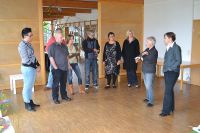International Bachelor in Floristry & Design: strong foundation is laid

From 12 till 15 of June to be precise, the second plenary meeting took place of the project officially called the European Master in Floral Design. Much was discussed and some important issues were tackled, as been described in detail below.
During the first plenary partner meeting (end of April in Venlo (NL), one of the key concerns was on which level this renewed EMFD education should be placed. As the standard of the EQF (European Qualifications Framework) and NQF-levels (National Qualifications Framework) did not yet exist in 2006 it couldn’t easily be said on what level the original EMFD and the by FLORNET 9 developed international modules were. Most probably it would have been classified as EQF/NQF level 4+, or perhaps 5.
The partners group involved in the redevelopment of the EMFD concluded, however, that considering the levels of existing studies it would be far better to aim for a higher target: NQF-level 6, or the Bachelor degree. A clear need for education on such a level is perceived in the market, as it does not exist in most European countries as yet.
This choice lead to reflections on the name ‘European Master’, which was opted for a while back as it would signify a top-level education above all existing national floral Masters. In hindsight, however, the title is seen as rather controversial and confusing, as the education will not formally be at the (EQF) Masters level but thus most likely at the Bachelor level. All things considered, the conclusion in the end was that it would be better to use the new name: International Bachelor in Floristry & Design
During the three days of the recent meeting at the Staatliche Fachschule für Blumenkunst Weihenstephan in Freising (DE) the main focus was on the detailed professional profile, which forms the basis for the educational profile and thus the curriculum for this new type of education. It took some long and complex discussions to agree on all the details of this professional profile: it should not only have sufficient labour market relevance, but should also have sufficient coherence with existing vocational education in floristry as well with the Dublin descriptors, as otherwise adequate influx into this new course could pose a problem.
An obvious extra complication was the differences in the existing national vocational education systems as well as the diverging ideas regarding the principle of “competence-based learning”. Nevertheless the group managed to reach agreement and complete the professional profile for the IBFD in the end.
This means that a sound foundation has been laid for the remaining work that needs to be done in the coming year. Some 6 more meetings to go till June 2013 and then the complete curriculum for the international bachelors education in floristry needs to be finished. A big challenge, but all partners are convinced it can be done!
Partners in this project are:
- FLORINT, International Florist Organisation
- AOC de Groene Welle (NL)
- Staatliche Fachschule für Blumenkunst Weihenstephan (DE)
- Blomsterdekoratørfagets opplaeringskontor - BLOK (NO)
- Vea - Statens fagskole for gartnere og blomsterdekoratører (NO)
- Wageningen University, chair Competence Based education (NL)
Silent partners are:
- Keski-Uudenmaan ammattiopisto Mäntsälä/Keuda Vocational College Mäntsälä (FI)
- Ucflor - Unione cooperativa floricoltori della Riviera (IT)
 The EMFD / IBFD project is made possible by funding from the European Commission.
The EMFD / IBFD project is made possible by funding from the European Commission.
20th of June 2012



